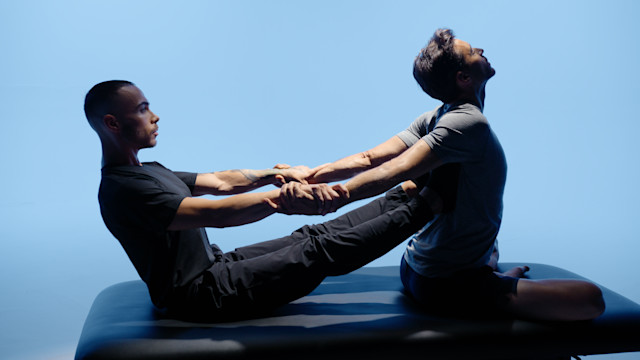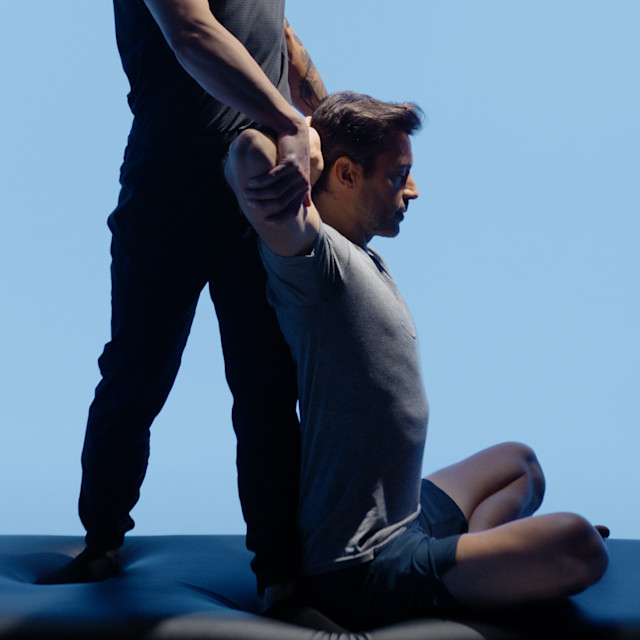Get an inside look at what it’s like to go deeper with your recovery with personalized, assisted stretch sessions at Equinox.
I Tried is a series that spotlights an individual as they experience an Equinox offering for one month. In this installment, writer Alyssa Sparacino tries One-to-One Stretching now available at The Spa at Equinox.
As someone who prioritizes an active lifestyle — hiking, long walks with my dog, and my strength training workouts are among my favorite ways to stay moving — I know what my body feels like when I don’t also prioritize recovery.
Mobility work and some quick stretches make a regular appearance in my workout routine, but I’m not going to pretend and say I stretch after every workout and always warm up properly. (I’ll leave that fibbing to when I tell my dentist I floss every day.)
So, when I heard that Equinox was offering a way to commit to my mobility and recovery in a way that felt almost like getting a massage — but with even more benefits — I couldn’t sign up fast enough. Once a week for a little more than a month I came in to meet my excellent stretch therapist Linda O’Donovan, LMT, for 30-minute one-to-one assisted stretching sessions.
RELATED: Stretching Gets Personal
Members can book assisted stretching sessions within The Spa at select Club locations in New York City. Licensed massage therapists provide a comprehensive approach — combining both Eastern and Western techniques — as well as creating a highly individualized roadmap for each session and member, explains Liz Bartucci, senior regional spa manager at Equinox. Every body is different, and even then, as I found to be true myself, your body adapts and changes on a daily and weekly basis due to everything from your sleeping positions to your recent workouts.
Speaking of your recent workouts, the kind of passive stretching I experienced at Equinox is designed to allow those hard-worked muscles some well-deserved relaxation. Stretching helps release muscular tension to speed up the healing process by flushing out lactic acid through increasing blood flow, says O’Donovan. Lactic acid, a natural byproduct of exercise, is responsible for that familiar soreness, stiffness, and fatigue you feel after training, she says.
RELATED: I Tried: LightStim LED Therapy
In addition to recovery, stretching has some serious performance benefits, too. Circulating oxygenated blood through stretching helps elongate your muscles and increase range of motion, which allows you to use the full power and length of that muscle for better gains, adds O’Donovan. Not to mention, better mobility, or a joint’s ability to move through its full range of motion, is vital to healthy aging and injury prevention as you’re able to move freely and completely.
With all these potential body benefits awaiting me, I was eager to hop on the stretching table and get started. Here’s how it went.
Week One: Getting Reacquainted with My Body
I met Linda at Equinox Gramercy for my first session, and we chatted about my activity level (four to five workouts a week + everyday movement), favorite workouts (Pilates and weight training), prior injuries, areas of concern (hips, glutes, forearms, upper back), and solo stretch routine (there but could be more consistent).
To get started, I laid down on the cushioned (and wipeable — the surface was always cleaned before every session) therapy table, and Linda started gently assessing my range of motion and flexibility from top to bottom. I changed positions as needed (prone, supine, on my sides), as she slowly moved my limbs around each joint (think: slow rolls through the hip socket, shoulders, and wrists) to pay careful attention to points of friction.
We were immediately able to pinpoint some areas I already knew to be tight, like my hip flexors and calves, but she also found some sneaky spots — my inner thighs and biceps — that were holding a lot more tension than I realized.
All in all, I was intrigued to add this extra layer of body awareness and excited about how I already felt lighter and more limber by the end of this first session.

Week Two: Zeroing In On My Tender Spots
Linda and I got to work quickly on some of those stiff spots she identified the week prior. As she started manipulating my body — this might sound jarring, but Linda always talked me through each step, such as why she was asking me to change positions, or how she wanted me to relax so I always knew not just what was coming next but why — she would find specific points along a muscle that were holding tension.
Simultaneously applying pressure to this area while moving a joint through my range of motion allowed the muscle to relax. Oftentimes, I could physically feel the “ahh” moment when the area would release, but even when it was more subtle, I always knew it worked when Linda would say, “Ah, there it is!” and my body finally let go.
My forearms have always given me trouble. I work on a laptop all day, so this, coupled with regularly gripping and lifting heavy weights and scrolling on my phone (guilty), leaves them feeling sore and stiff. So, when Linda found a pressure point on the front of my forearm, asked me to circle my wrist, and I felt it release, I was hooked. I joked that I’d come back for sessions just for that. During just this single 30-minute session, we identified several points of tension in my hamstrings, quads, inner thigh, biceps, and, yes, my forearms.
Weeks Three and Four: Going Deeper
At this stage in our work together, Linda and I made great use of every minute, working efficiently to get the most head-to-toe relief possible. Linda used many of the same techniques and tricks she always had, but we also started implementing reciprocal inhibition, which involves contracting one muscle to relax another. In my sessions, I would often squeeze my glutes to help release my hip flexors, for example.
We also did a lot of PNF (or proprioceptive neuromuscular facilitation) stretching, which involves contracting a muscle or muscle group to increase that area’s flexibility and range of motion. In my case, we often used PNF to release my hamstrings (with Linda supporting my leg in the air, I’d squeeze my hamstrings isometrically, let go, and she’d then be able to stretch that side even further) and my quadriceps (side-lying with a bent leg, I’d contract my quad to push against Linda’s palm, release, and she’d then be able to find greater mobility in that thigh).
As a certified personal trainer myself, I’m aware of how muscle groups work together or against each other, but revisiting this concept, and learning even more about how it can be applied to stretching and mobility, was really helpful. This educational aspect of my stretching sessions ended up being one of my favorite lessons from the entire experience.
Week 5: Letting It All Flow
During our last session together, Linda worked on my mobility seamlessly, running through all my key areas that she now knew like the back of her hand. She combined all of her go-to techniques for a holistic approach to my therapy — and even paid special attention to my forearms since she knew just how much I appreciated that release each week.
My Final Takeaways
All in all, I got off the table after each session not only feeling looser and lighter but also smarter, as I consistently learned something new about my body that I could take into my solo stretches, warmups, and even my workouts. What’s more, after the entire month-plus of working with Linda regularly, I can say that without a doubt, I’m moving with more confidence and ease.
Prioritizing stretching and mobility training these last several weeks has improved not just my flexibility, but also how I move my body throughout every part of my day — from my walk to work to my high-intensity training days. It’s reignited my dedication to mobility work now, so I can stay active and healthy for many years to come.
